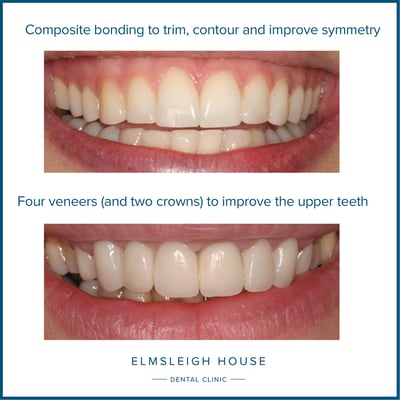
Both composite bonding and veneers are dental procedures used to enhance the appearance of teeth, but they have some key differences in terms of material used, purpose, durability, preparation and cost.

Composite bonding: Composite bonding involves the application of a tooth-coloured resin material directly onto the tooth. This resin is the same material used for tooth-coloured fillings.
Veneers: Veneers are thin, custom-made shells typically made of porcelain or ceramic. These shells are fabricated in a dental laboratory and then bonded to the front surface of the teeth.
Composite bonding: Bonding is often used to repair chipped or cracked teeth, close gaps between teeth, change the shape of teeth or improve the appearance of discoloured teeth. It is a more versatile solution for minor cosmetic issues.
Veneers: Veneers are primarily used for cosmetic purposes to improve the appearance of stained, misaligned, uneven or worn down teeth. They provide a more dramatic transformation and can change the shape, size and colour of teeth significantly.
Composite bonding: While durable, composite bonding is more prone to staining and may not last as long as veneers, especially if the bonded teeth are exposed to staining substances such as coffee, tea or tobacco.
Veneers: Veneers are highly stain-resistant and generally more durable than composite bonding. With proper care, they can last for many years.
Composite bonding: Minimal preparation is needed for bonding. The dentist roughens the tooth's surface slightly and applies the bonding material directly onto the tooth.
Veneers: The preparation for veneers usually involves removing a small amount of the tooth enamel (about 0.5 mm) to create space for the veneer. This is a permanent alteration to the tooth.
Composite bonding: Generally, bonding is more affordable than veneers. It is a quicker, minimally invasive and more cost-effective solution for minor cosmetic issues.
Veneers: Veneers are more expensive due to the custom fabrication process and the materials used. As they involve removing a small amount of teeth enamel, they are used in specific instances rather than routinely.
When deciding between composite bonding and veneers, your dentist will assess your specific dental needs and recommend the most suitable option based on the extent of the cosmetic issues and your budget.